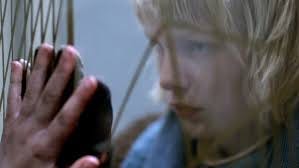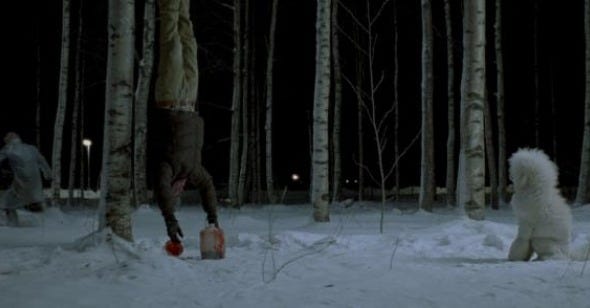Loneliness in Let the Right One In.
A Study of Isolation, Connection, and Redemption.
Let the Right One In, the 2004 novel by Swedish author John Ajvide Lindqvist, and its subsequent 2008 film adaptation by director Tomas Alfredson, present a haunting yet intimate portrayal of loneliness. Set against the bleak, desolate backdrop of a small, snow-covered town in Sweden, the story follows twelve-year-old Oskar, a bullied, isolated boy, and Eli, a centuries-old vampire child. Their friendship emerges as a powerful exploration of loneliness, encapsulating themes of isolation, connection, and the search for redemption amidst the alienating realities of modern life.
The story takes place in the 1980s in a working-class neighborhood of Blackeberg, Stockholm—a place that feels inherently isolated, not just geographically but emotionally. Through Oskar’s and Eli’s experiences, Lindqvist and Alfredson delve into loneliness as both an individual and a social condition. Oskar is an outcast in his school and suffers constant bullying; he is marginalized, and his alienation is compounded by his estrangement from his parents. His father is an alcoholic and his mother, though loving, is somewhat detached. The lack of a nurturing, stable family life leaves Oskar without a secure attachment, making him susceptible to loneliness and lacking the resources to face his emotional struggles.
Eli, on the other hand, is an outcast of a different kind. Despite her childlike appearance, she is a centuries-old vampire bound to an existence of eternal isolation. Her loneliness is existential, as she is unable to form human connections due to her supernatural nature. The social disconnection she experiences is a literal representation of the isolation that Oskar experiences in a figurative sense. Eli’s unchanging appearance forces her into a transient life where relationships are fleeting and identity must constantly be hidden, which mirrors the ways people in society often feel compelled to conceal their true selves to avoid rejection or judgment.
Loneliness in Let the Right One In is not solely about despair; it is also about the possibility of connection. When Oskar meets Eli, he finds a friend who, despite her secret and her need for blood, understands his pain. The bond they form is unique, forged in shared silence, unspoken understanding, and mutual acceptance. They are both outcasts, misunderstood and isolated in a world that offers little in terms of compassion. Their connection provides them with an antidote to their loneliness, and in each other, they find solace and even hope.
Oskar’s interactions with Eli give him the courage to confront his bullies, indicating that human connection can empower individuals to face fears and challenges. Eli’s friendship with Oskar, meanwhile, allows her to experience vulnerability and companionship—feelings that her vampiric nature had long denied her. This connection not only humanizes her but also enables her to exist in a way that is more empathetic, suggesting that the essence of humanity can survive even in the face of monstrousness.
While Oskar and Eli’s friendship provides relief from their loneliness, it does not offer a straightforward path to redemption. The relationship they form is tinged with ambiguity. Eli’s dependence on blood to survive raises moral questions about her nature and her influence on Oskar. In the film’s climactic scene, Eli saves Oskar from his tormentors, violently and decisively. This act of violence complicates the relationship, as Oskar’s liberation from loneliness comes at a great ethical cost. Eli becomes both a savior and a danger, blurring the lines between love and corruption, friendship and exploitation.
The relationship questions whether love or connection can truly redeem us or if it simply offers a temporary reprieve from loneliness. For Oskar, the bond with Eli leads him down a morally ambiguous path, one that isolates him further from society. He chooses to leave his home and follow Eli, suggesting that, while their connection provides a sense of belonging, it also alienates him from the rest of the world. This decision underscores the duality of human connections: they can provide comfort and companionship, but they can also create new forms of isolation when they exist outside societal norms.
In Alfredson’s film adaptation, the cinematography heightens the sense of isolation. Snow-covered landscapes, stark interiors, and cold lighting evoke a world that feels inhospitable and uninviting. The choice of setting—a remote, nondescript town—emphasizes the characters’ sense of entrapment, as if they are unable to escape their circumstances. Each scene is framed with careful attention to space, often leaving the characters dwarfed by their surroundings, which visually reinforces their loneliness.
The film’s muted color palette and sparse dialogue contribute to an atmosphere where silence speaks louder than words. In moments of quietude, the viewer is drawn into the characters’ inner worlds, forced to confront the vast emptiness that engulfs them. Alfredson’s direction complements Lindqvist’s narrative, creating a haunting yet subtle portrayal of loneliness that is as unsettling as it is beautiful.
Though Let the Right One In is specific in its narrative, the emotions it explores are universal. Loneliness is an experience that resonates across cultures and time periods. Lindqvist’s novel and Alfredson’s adaptation succeed because they tap into a fundamental human need: the desire for connection, understanding, and acceptance. The relationship between Oskar and Eli speaks to a deep-seated need to find someone who sees us for who we are, in all our imperfections and peculiarities.
The story serves as a reminder that loneliness can make people vulnerable, but it can also foster resilience and compassion. Oskar’s capacity for empathy and Eli’s ultimate willingness to protect him reflect a truth about loneliness—that it can drive individuals to seek connection in surprising places, and, sometimes, that connection can lead to transformative change.
In Let the Right One In, loneliness is a multifaceted experience, one that encompasses both pain and possibility. Oskar and Eli’s relationship challenges the idea that loneliness is something to be feared and avoided at all costs. Instead, it suggests that loneliness can lead to self-discovery and connection, albeit in complex and often morally ambiguous ways.
The novel and film ultimately present loneliness as an inescapable aspect of the human condition, one that shapes identities and drives individuals toward each other, despite—or perhaps because of—their differences. In a world that can feel cold and unforgiving, the bond between Oskar and Eli is a testament to the ways in which companionship can transform isolation, if only briefly, into something profound and redemptive. Let the Right One In reminds us that, sometimes, in our darkest moments, all it takes is one person—one connection—to bring us out of the shadows and into the light.
Winter Communion.
In the silence of snow—
white skin stretching over the earth,
bare trees shivering with what they must hold—
there is a boy, alone.
And a girl, though we know she is not,
not really,
not the way she stands there,
the way she waits, in that dark coat.
A small, dark shape in the fading light.
The boy steps forward, a breath held like a wound,
tenderly raw in his body.
He is all bruises, winter-washed,
the world too heavy on him.
The night too close.
She lifts her hand, just so,
and he knows, without her saying,
the terrible grace of someone seeing you,
the sharp mercy in it—
how it slices the distance between them.
And in this bare exchange, this brittle communion,
a pact is born, and he is no longer a boy.
Now he is something else, something other.
The world will not know him,
not after this.
At the edge of the frozen field,
the stars falter, wanting to turn away,
and the snow, so silent, presses down,
sealing up their tracks, as if
none of this,
none of it
had ever been seen.







"The terrible grace of someone seeing you" WOW, that's such a profound statement! Great piece. The poem is a perfect representation of the film! Well done! ✨
Very interesting, and I love the poem.